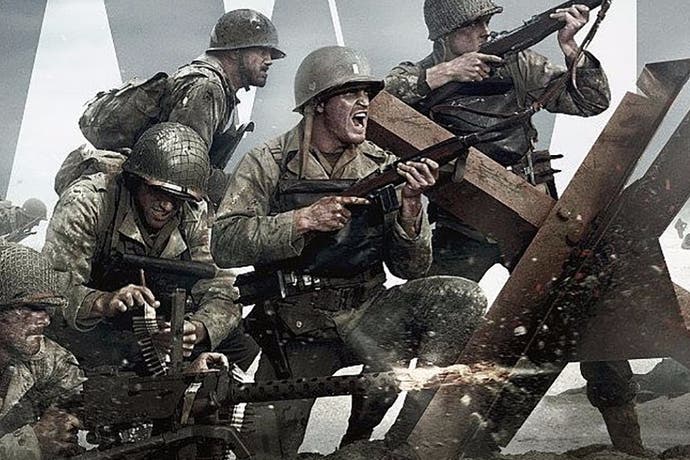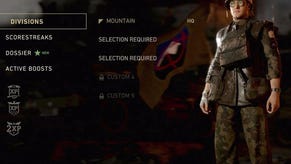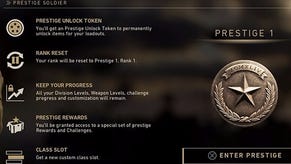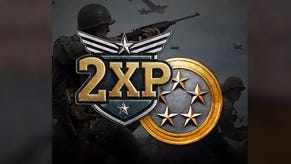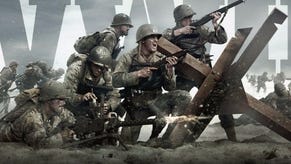Searching for the past in the Call of Duty: WW2 beta
Making and breaking history.
So we're fighting the Nazis again. And in the game. Call of Duty's return to the heroism-soaked beaches and foxholes of World War 2 is either providentially or unfortunately timed. Wolfenstein and Sniper Elite's fine efforts notwithstanding, I'd sort of forgotten that National Socialism was once the industry's second favourite foe (its favourite being zombies, which are both dependably noxious and, as mindless cannibals, easier to design around), and it's odd to be kicking the crap out of them, or indeed kicking crap as them, in the context of a genuine far-right resurgence.
Small wonder that actual National Socialist iconography is absent from the game's multiplayer, or that National Socialism's obsession with racial purity and patriarchal values doesn't apply when it comes to customising your avatar. Call of Duty: World War 2 may style itself an authentic recreation in places, but it's governed by the understanding that history is always a Machiavellian fabrication, a daydream that trades in the appearance of fidelity for political force. In a world where a For Honor emote derived from an 11th century papal address can become an accidental rallying point for alt-right trolls, it repays developers to be selective when assembling their visions of the past.
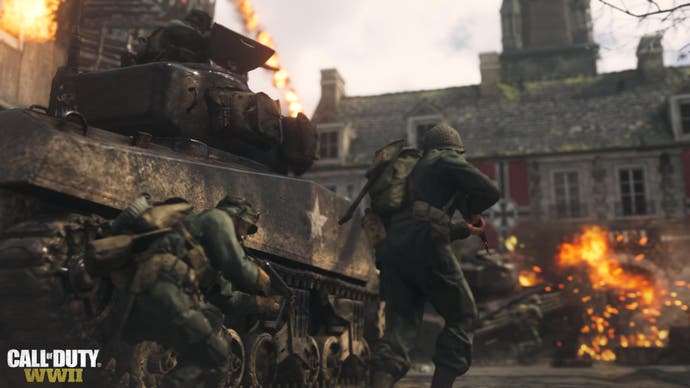
Call of Duty: World War 2 isn't just a selective representation of World War 2, of course - it's a selective representation of Call of Duty's original WW2 phase, as much a continuation of lessons learned in the Modern/Advanced Warfare years as it is a back-to-basics reboot. Fire up the Pointe du Hoc map in this weekend's beta and you might feel like you're storming trenches in Call of Duty 2, but this is a vista refracted through the prisms of later games. Most obviously, there are all the usual killstreaks: Modern Warfare's radar sweep, the competitive MP equivalent of the Wilhelm scream; on-rails turret gunning from Modern Warfare 2; a posse of AI-controlled paratroopers who recall World of War's legendary attack dogs.
The maps, moreover, have a slight whiff of Black Ops 3 and Infinite Warfare's exosuit-friendly design to them, their hoppable barricades and winding, sheltered canyons encouraging you to build up momentum even in the absence of wall-running or the boost-jump. While the arsenal has been boiled back to sturdy mainstays like SMGs and assault rifles, following the Destiny-esque loot sprawl of Infinite Warfare, there are still gizmos that (while of course based on the technology of the era) pay covert homage to that game's sci-fantasy excesses, such as incendiary shells or slugs that transform shotguns into sniper rifles.
There's also the post-match screen, which is a slightly bizarre attempt to bridge the gap between online trash-talk and the gravitas of a film like Saving Private Ryan. As in Black Ops 3, if you're one of the top three scorers you can throw emotes at the losers in the lobby - but where Black Ops 3's emotes were all grabbed crotches and vigorous chest-beating, reflecting a series that has internalised the macho abrasiveness of eSports tournament culture, WW2's gesture system skews respectable, with bursts of polite applause and crisp salutes. Because you can't have the heroes of Operation Market Garden doing swerves or miming heart attacks when they beat the Krauts - it just wouldn't be appropriate. Or can you? There are probably "fruitier" gestures to unlock in the final game. I'm eager to see the reactions, both from players themselves and from the likes of the Daily Telegraph.
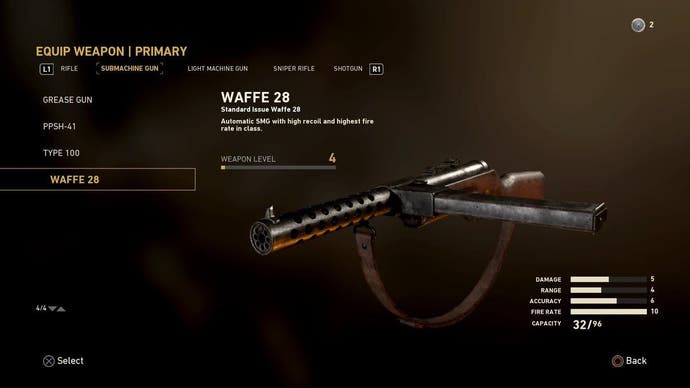
There's a similar air of irreverence to the process of choosing your class. Call of Duty's unlockable perks are now sorted into "Divisions", quasi-factions with a lightweight narrative wrapper. Each Division gets its own intro trailer, a recruitment reel-style breakdown that brings back fond memories of Command & Conquer: Red Alert's camp-tastic live-action cutscenes. The Armored Division (think LMGs and explosives) is fronted by a British officer so prim and proper you could use him as a clothes horse. "This fellow will stop a tank in its tracks," he remarks of the game's bazooka. "Or give an enemy bunker a right good thrashing." The Expeditionary Division, meanwhile, features an African-French soldier who signs off with a vehement "Vive la resistance". You keep waiting for Tim Curry to fall out of a cupboard. If the campaign is cast in the image of Band of Brothers, Call of Duty: WW2's multiplayer has its sights on something like the sardonic alt-history vibe of Wolfenstein: The New Order.
Elsewhere, the game takes inspiration from Overwatch, in the shape of Play of the Game-style match highlight cinematics, and Battlefield, in the shape of War Mode, a condensed riff on Rush mode from Battlefield: Bad Company (you can also trace the thinking here to Killzone 3's Operations mode, though I never played that). The nod to Overwatch is unconvincing so far, because Call of Duty doesn't have nearly the same range of playstyles as in Blizzard's game and thus, those highlight reels have a tendency to blur into one. War Mode, however, feels like it could be Call of Duty: WW2's silver bullet - it sees you contesting a range of objectives across a large, linear map that is essentially a procession of linked mini-maps.
Playing as the Allies, you might have to conquer a German radio post, then build a bridge so that you can escort a tank to an ammunition dump, then blow up the latter before mounting a final assault on an AA position. It's a great setup both because it creates variety, and because, as a mode that involves a moving battlefront, it avoids one of the common anxieties in Call of Duty - the constant dread that somebody is coming up behind you, thanks to looping routes and shifting spawnpoints.
Call of Duty: WW2 has been pitched as a game for the weary veteran duty-caller, the player who longs for the days before the streaks and unlockables took over, when you didn't have to worry about things like holographic decoys or suits of juggernaut armour. It certainly ticks that box, but for me the fascinating thing about is how it preserves many of those more recent innovations in a nostalgic guise, finding new ways to express those ideas even as it kicks Advanced Warfare's cybernetic trappings to the curb. As for whether it will find anything meaningful to say about contemporary fascism, well - I'm not holding my breath, but a game in which you can play an African-German female Nazi is probably more subversive than it seems.
